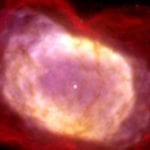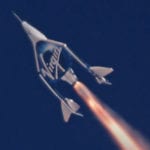 Creepy
Creepy  Creepy
Creepy  Technology
Technology 10 Scientific Breakthroughs of 2025 That’ll Change Everything
 Our World
Our World 10 Ways Icelandic Culture Makes Other Countries Look Boring
 Misconceptions
Misconceptions 10 Common Misconceptions About the Victorian Era
 Mysteries
Mysteries 10 Strange Unexplained Mysteries of 2025
 Miscellaneous
Miscellaneous 10 of History’s Most Bell-Ringing Finishing Moves
 History
History 10 Great Escapes That Ended Right Back in Captivity
 Weird Stuff
Weird Stuff 10 Fascinating Things You Might Not Know About Spiders
 Food
Food 10 Everyday Foods You Didn’t Know Were Invented by the U.S. Military
 History
History 10 Odd Things Colonial Americans Kept at Home
 Creepy
Creepy 10 More Representations of Death from Myth, Legend, and Folktale
 Technology
Technology 10 Scientific Breakthroughs of 2025 That’ll Change Everything
 Our World
Our World 10 Ways Icelandic Culture Makes Other Countries Look Boring
Who's Behind Listverse?

Jamie Frater
Head Editor
Jamie founded Listverse due to an insatiable desire to share fascinating, obscure, and bizarre facts. He has been a guest speaker on numerous national radio and television stations and is a five time published author.
More About Us Misconceptions
Misconceptions 10 Common Misconceptions About the Victorian Era
 Mysteries
Mysteries 10 Strange Unexplained Mysteries of 2025
 Miscellaneous
Miscellaneous 10 of History’s Most Bell-Ringing Finishing Moves
 History
History 10 Great Escapes That Ended Right Back in Captivity
 Weird Stuff
Weird Stuff 10 Fascinating Things You Might Not Know About Spiders
 Food
Food 10 Everyday Foods You Didn’t Know Were Invented by the U.S. Military
 History
History 10 Odd Things Colonial Americans Kept at Home
10 Recent Space Discoveries No One Can Explain
The universe loves to confuse us. And sometimes, the discoveries that benefit science the most are those that leave us severely confused and scrambling for crazy explanations.
10The Moon’s Mysterious Magnetic Field

The Moon has remained magnetically inert for eons, but new research confirms that this was not always the case. Over four billion years ago, an inner molten moon-core whirled against a lunar mantle, much like Earth’s own dynamo, and a potent magnetic shield extended from the Moon. But this was presumably a much weaker version than Earth’s, since the satellite obviously lack’s Earth’s heft, right?
Surprisingly, our scrawny little moon was actually able to generate a mightier field than ours. No one knows why such a puny body displayed such potent magnetic activity, with current answers running the gamut from “we don’t know” to “magic?” The mystery reveals that there’s yet another unknown set of variables regarding our most intimately studied partner. It appears the early Moon took advantage of some exotic method to produce its awesome magnetic field. And it managed this for longer than astronomers previously thought was possible, perhaps due to constant meteor impacts that fueled Luna’s magnetism.
It appears that the field disappeared sometime around 3.8–4 billion years ago, though more research is necessary to find out exactly why. Surprisingly, studies suggest that the Moon’s core is still at least slightly liquid. So even though the Moon is within reaching distance, we’re constantly reminded that there are many fundamental questions we’ve yet to answer about lunar geology.
9Galaxies 13 Billion Years Old
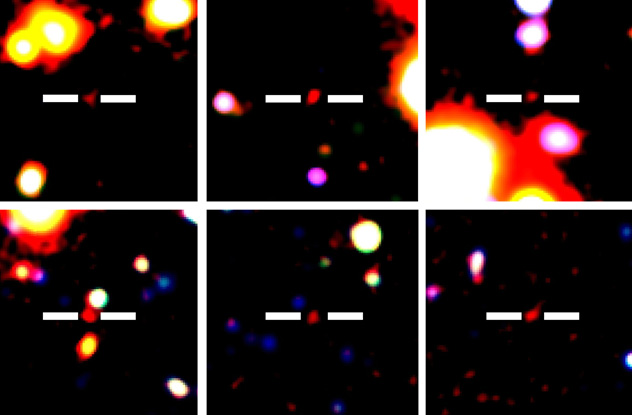
The early universe was an approximation of hell—a roiling, opaquely dense stew of electrons and protons. Almost half a billion years passed before the baby universe cooled down enough to allow the formation of neutrons. Shortly thereafter, the universal landscape settled further so that stars and galaxies could come into being.
A recent ultra-deep survey by the Subaru telescope—located in Hawaii and run by the National Astronomical Observatory of Japan—revealed seven of the earliest galaxies ever. Over 13 billion light-years distant, they appeared as unimaginably faint pinpricks of light. In fact, they were visible only after Subaru focused on a tiny patch of sky for over 100 hours of exposure.
Born only 700 million years after the big bang exploded everything into existence, these galaxies are among the earliest things ever observed and are among the first evidence of organization within the universe. These types of galaxies are characterized by intense hydrogen excitation and an absence of heavier elements since metals (other than minute amounts of lithium) hadn’t been blasted into existence yet by supernovae.
Termed Lyman-alpha emitters (LAE), these galaxies appeared suddenly and for (more or less) unknown reasons. LAE galaxies are prolific star-producers, and their extreme age offers insight into the evolution of the universe. However, astronomers aren’t sure if the ones captured by Subaru were newly formed or if they’d been present and were only made visible by a thinning of the cosmic gas that initially obscured them.
8Titan’s Magic Island
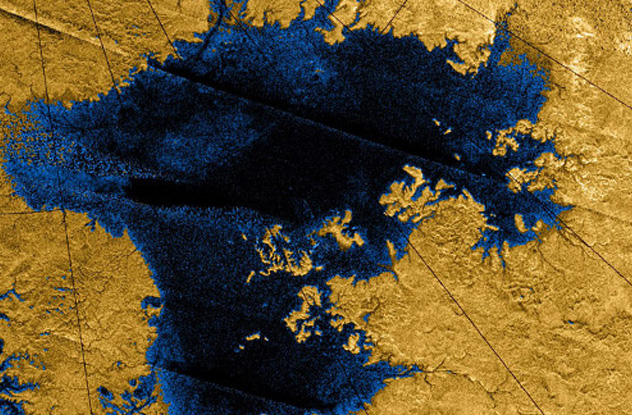
Saturn’s largest moon, Titan, might be the most intriguing member of the solar system. It’s a primeval Earth, complete with an atmosphere, liquid bodies, and even suggestions of geological activity.
In 2013, the orbiting Cassini spacecraft spotted a brand new chunk of land that mysteriously appeared out of Titan’s second-largest sea, Ligeria Mare. Shortly thereafter, the “Magic Island” disappeared just as mysteriously into the translucent, –200 degree Celsius (–290 °F) methane-ethane sea. And then it reappeared again as a much larger landmass during one of Cassini’s recent radar sweeps of Titan.
The transient land confirms the supposition that Titan’s alien oceans and seas are dynamic components of an active environment, rather than static features. However, astronomers are at a loss to explain the physical processes responsible for the ephemeral landmass. Especially since it appears to have doubled in size—from 50 to 100 kilometers (30 to 60 mi) across—since it reappeared.
7The Asteroid With Rings
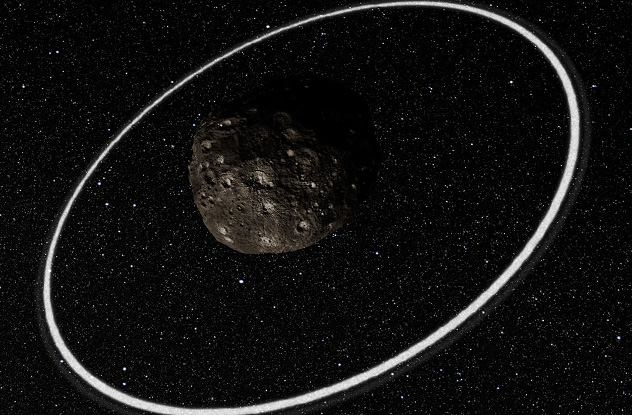
All our gas giants are encircled by rings, though most of these are tenuous wisps of debris quite unlike Saturn’s massive sets of bling. And now, for the first time and quite unexpectedly, astronomers have found rings around a much smaller body. Meet Chariklo, an asteroid measuring only 250 kilometers (155 mi) across yet boasting its own ring system.
Chariklo, though the largest object in its cosmic vicinity, looked like an unremarkable chunk of space rock. Then astronomers noticed its anomalous light signature. As it eclipsed a faraway star, it caused an unanticipated dip in the amount of light reaching our telescopes. The dimming action occurred immediately before and after it crossed the star’s path, causing momentary confusion.
It turns out that Chariklo sports not one but two cosmic necklaces. Containing a good amount of frozen water, the larger of the rings hugging the planet is 7 kilometers (4 mi) wide, while the smaller is about half that size.
And while some asteroids do have “moons”—tiny satellites dancing around them—Chariklo is unique because a ring around an asteroid had never been observed. The rings’ origin is unclear, though it appears they were formed by an impact. They are either the remnants of a foreign body that shattered itself against Chariklo or pieces of Chariklo itself that blew off during the crash.
6UV Underproduction

We pride ourselves on ascertaining the many universal balances that seem to occur throughout the cosmos. One such correlation has been observed between ultraviolet light and hydrogen, as the two have been found to coexist in well-defined proportions.
A recent survey, however, has thrown a monkey wrench into these suppositions and reported a severe underproduction of UV photons from known sources—a 400-percent discrepancy compared to predicted values. Lead author Juna Kollmeier likens it to walking into a dazzlingly bright room only to find several dim bulbs responsible for the disproportionate brilliance.
Two accepted processes produce UV radiation—unruly young stars and massive black holes—but more UV radiation exists than could have been produced by the two. Astronomers can’t explain the superfluous UV production and are forced to admit that “at least one thing we thought we knew about the present-day universe isn’t true.” That’s quite disheartening, considering that UV-hydrogen balance was believed to be very well understood. As in many times in the past, astronomers are forced back to the drawing board.
Quite mysteriously, this UV underproduction is only apparent at local distances. When looking farther off into space and time, astronomers find that their predictions hold up quite well. They’re remaining optimistic, though, since the unaccounted radiation could be the result of exotic, heretofore undiscovered processes. These possibly even involve dark matter decay.
5Weird X-rays
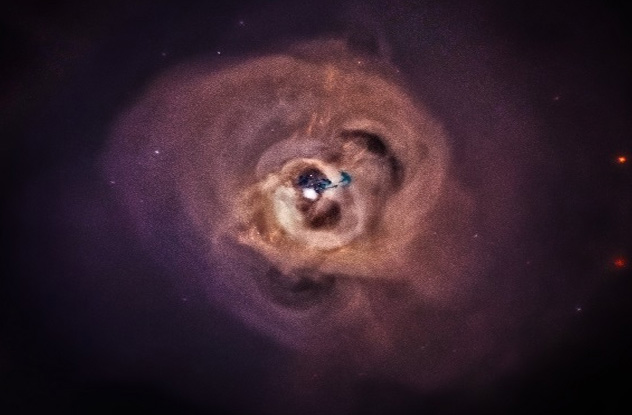
Odd X-ray pulses are streaming from the core of the Andromeda and Perseus galaxies. And the signals’ spectrum (or light signature) does not match any known particle or atom. So astronomers are tentatively salivating over the prospect of a scientific breakthrough, as this phenomenon could just be the first tangible sign of dark matter.
Dark matter—the elusive, invisible bulk that accounts for most of the mass in the universe—might be composed of sterile neutrinos, which may or may not exist depending on whom you ask. These theorized particles supposedly produce X-rays in their death throes, and such emissions could account for the unexplained surges from the center of the aforementioned galaxies.
Furthermore, since the radiation emanates from the cores of the galaxies, it corresponds to areas of highly concentrated dark matter clumps. So while nothing is certain yet, this could be a momentous discovery that would greatly increase our understanding of a long-standing universal mystery.
4The Six-Tailed Asteroid
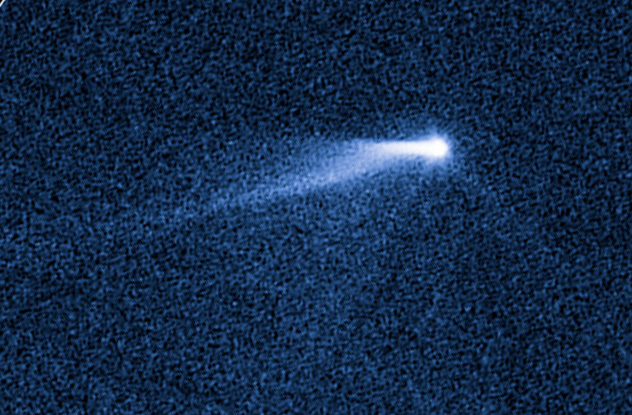
Hubble has revealed yet another incredible curiosity—an asteroid that thinks it’s a comet. While the latter bodies are easily recognized by their bright, streaming tails, asteroids do not usually have such features since they possess little ice and are made mostly of heavier elements and rock. So spotting an asteroid with not one but six tails was an incredible surprise.
Asteroid P/2013 P5 is a unique find with its six spouting jets, as all other pieces of cosmic debris are quite content with considerably fewer. It blasts material indiscriminately into space like a cosmic lawn sprinkler
It’s unclear why the object behaves and looks the way it does. One awesomely destructive possibility is that P5 is rotating so quickly that it’s inadvertently killing itself. Its tiny gravity is no match for the greater rotational forces ripping it apart. And radiation pressure from solar emissions stretches the scattering debris into dazzling, comet-like appendages.
However, astronomers do know that P5 is a leftover chunk from a previous impact. The tails most likely contain zero ice content, since frozen water is unlikely to be found in an object that’s been previously exploded to 800 degrees Celsius (1,500 °F).
3HD 106906b, The Distant Monster
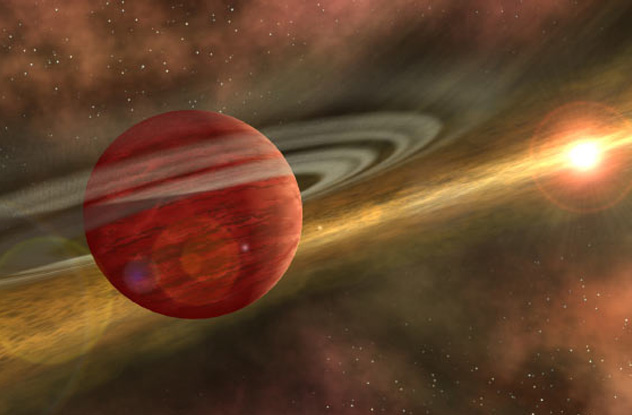
Planet HD 106906b is a head-scratcher. This super-monster is 11 times more massive than Jupiter, and its gaping orbit highlights all sorts of flaws in our tenuous understanding of planetary formation. HD’s distance from its parent star is an absolutely mind-boggling 650 astronomical units (AU).
The incredibly lonely Neptune, our most distant planet, lumbers around the Sun at a distance of 30 AU. This is already an amazing range, but HD is so far separated from its parent that Neptune and the Sun are comparatively within hugging distance. This huge discrepancy is responsible for the addition of many asterisks above our planetary formation theories, as astronomers scramble to explain HD’s existence in spite of its vast orbit and heft.
For example, the forces responsible for making planets are usually undone by such great distances, raising the possibility that HD was created via the collapse of a debris ring. Yet HD is too massive for that to happen. And the primordial disks of raw matter that can birth planets simply do not contain enough stuff to produce giants like HD.
Another possibility is that we’ve discovered a failed binary star system, wherein HD failed to attract enough material to ignite fusion within its gassy bosom. However, the mass ratio between potential binaries is usually no more than 10:1. In HD’s case, however, we’re looking at a 100:1 disparity.
2Uranus Is Stormy
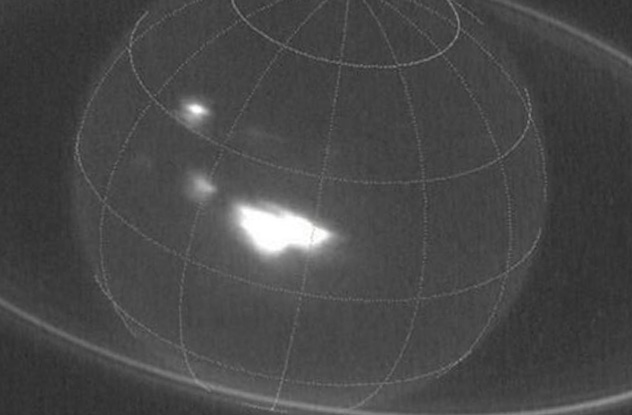
Astronomers have been caught completely off guard by Uranus. The second-farthest member of our solar family is typically frigidly calm, but for some odd reason, the planet is currently awash in raging storms.
Dazzling Uranian tempests were expected back in 2007, during its equinox as the planet completed half of its 82-year orbit, and the full solar fury was unleashed directly upon the equator. Yet the stormy weather was supposed to abate as Uranus continued its journey around the Sun. It hasn’t.
With no internal heat source, the green giant relies on solar exposure to fuel its storms. But astronomers from the University of Berkeley, California recently observed major activity in the planet’s upper region, a vast layer of frozen methane. Some of these storms are close to the size of Earth, spiraling through the planet’s atmosphere for thousands of miles and shining so intensely that even amateur astronomers can spot large patches of light across the surface.
It’s unclear how the storms managed to stay healthy without the Sun’s assistance. The northern hemisphere has plunged into shadow yet still continues to host violent storm fronts. However, it’s possible that vortexes deeper within the planet are caused by similar processes to those observed on the much more tumultuous Jupiter.
1KIC 2856960, The Triple-Star System
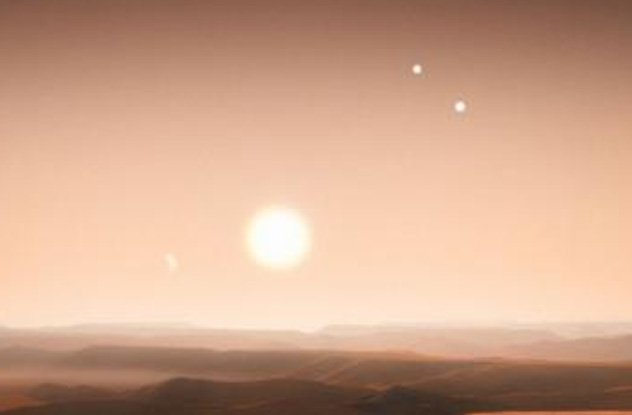
The Kepler Space Observatory is usually busy hunting down new planets, but it spent four years of its life tracking three gravitationally bound stars collectively known as KIC 2856960. KIC was just a run-of-the-mill triplet, two little dwarf stars orbited by a third stellar body going stag. Nothing weird so far, just three stars.
For example, Kepler saw four daily dips in the light curve as the binary dwarfs crossed each other every six hours. It also saw another slight decline in the observed light every 204 days caused by the eclipsing third star.
You’d think four years’ worth of observation would be enough to get well acquainted with KIC. And so did astronomers. But after fiddling with the numbers, the data didn’t make sense in the context of the observed behaviors of the stars. Their first job was to pin down the stellar masses. But no matter how they crunched the numbers, they failed to produce any sensible answers, even though ascertaining the mass of the stars should have been relatively straightforward.
For now, the stellar threesome has astronomers stumped. There is a potential answer that makes sense numerically yet not logically. It’s so farfetched to be almost unthinkable. The KIC system might contain a hidden fourth star. However, its orbit would have to perfectly mimic the orbit of the third star, giving the illusion of a single object.
